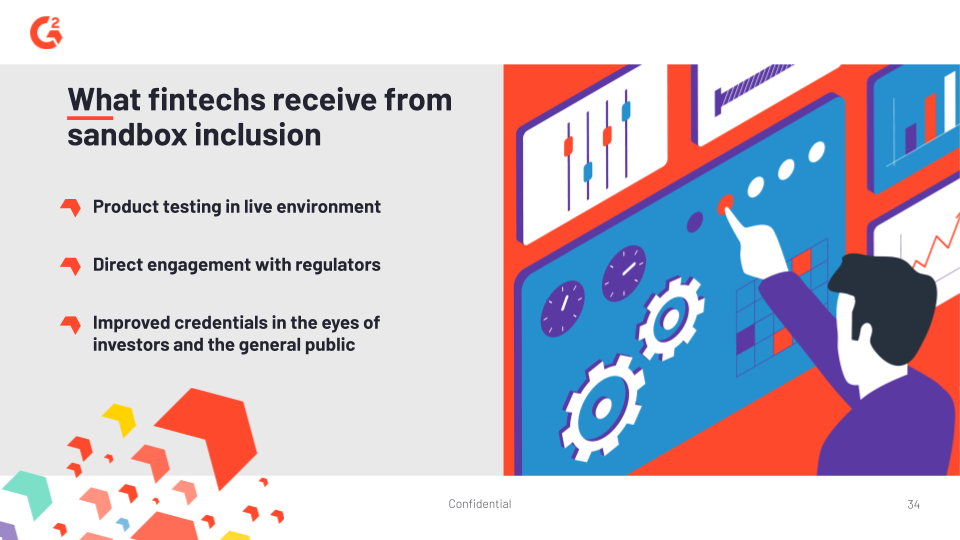Governments tout the use of fintech sandboxes as an excellent method of fostering innovative financial services technologies. Inclusion in these sandboxes gives fintechs a PR gold star along with a governmental stamp of approval.
However, the reality is much more complex—and worth diving into.
Fintech sandboxes: Are they vital to fintech development?
To untangle the complex web of fintechs, regulators, and financial services companies, we need to understand what the fintech sandbox is and how it came about.
Sandbox definition
In the tech world, a sandbox refers to a closed testing environment for users and developers to test out ideas. In other words, developers can test out ideas with no real-world consequence.
The UK’s Financial Conduct Authority (FCA) created the first official fintech sandbox in 2014, with an initial round of 24 accepted applications out of 69 applicants.
Fintech (regulatory) sandbox definition
The sandbox that fintechs use is a regulatory one, where they operate in a limited market under regulatory supervision. However, they don’t have to meet the standards of traditional operators.
The goal of launching and promoting fintech sandboxes? To encourage innovation, attract innovators to areas offering sandboxes, and investigate new products before they hit the open market.
Starting in the UK in 2014, regulators began looking to sandboxes to keep up with innovation and keep an eye on its pulse. The approach has worked so far: Christopher Woolard, the Director of strategy and competition at the Financial Conduct Authority (FCA), said that over 90% of the companies admitted the first round of the sandbox are now on the market.
Another benefit of these programs is the barriers to entry. The application and authorization process for access to these programs is rigorous, serving as a good test of a fintech’s mettle. The wild west days of fintech are ostensibly over, as regulators have a handle on the available technologies (not to say that more won’t be developed). Regulators started taking a keen interest in fintechs around 2015. The Office of the Currency Comptroller (OCC) proposed a fintech charter that would guide and lightly govern fintechs seeking to operate in the US. The charter has been torn apart and battled over since then, with many people calling it unnecessary and poorly constructed. While the charter may not have taken effect as intended, the past few years have seen fintechs come into the established financial services fold via acquisitions and partnerships.
Initially, the thought was that fintechs would skirt the existing regulatory bodies, but their need for legitimization as well as the resources of financial services incumbents has negating the need for additional regulation to bring them under the purview of existing financial services regulatory bodies. Fintechs realize that while their tech may be disruptive, governments will get involved no matter how anarchic or distributed the technology. As a result, fintechs must navigate murky regulatory waters that stand in their way of becoming a legitimate operation.
Fintechs put off by the process will have a challenging time trying to gain a legitimate foothold in the regulation-heavy financial services world. These organizations should spend their time looking for established partners to outsource the knowledge and experience required to go through that process.

Drawbacks to fintech sandboxes
There are several drawbacks to promoting these types of limited regulation environments. One is that acceptance into the program is seen as an external stamp of approval. With that approval serving as bait, investors are reeled in, fearful of missing out on the next big tech innovation. But such investment is not entirely warranted; that is ultimately down to the regulators and the standards of acceptance they’ve put together for their particular program.
Another potential drawback is that the sandbox may act as a sort of purgatory, pausing the company’s pursuit of actual regulatory approval in favor of playing around with product development in the sandbox. The risks inherent in setting up a fintech sandbox are magnified when looking at less financially developed countries, where there are many unbanked or underbanked individuals. The UK’s success is promising, but many governments—and their economies—limit a country’s ability to have a successful sandbox. Developing nations would be better off sinking resources into building an environment designed for fintech success than spending a lot of time and resources on setting up regulatory sandboxes.
| Related: Learn more about fintech’s expansion to the underbanked here. → |
How fintech sandboxes stack up
Despite the potential drawbacks, fintech sandboxes are a legitimate way of attracting innovators in what has historically been a staid industry riddled with stodgy suits reticent to embrace technology that could pose a risk to their highly regulated businesses.
Governments should not view fintech sandboxes as a silver bullet, but rather a cog in the innovation wheel. When coupled with things like innovation incubators, plugged-in investors and regulators, and well-crafted policies designed to promote smart advances in financial technology, sandboxes can be a boon to the entire financial system.
The argument against sandboxes (that they give credence to risky businesses) holds little weight. A pitfall is the potential of prompting investment in risky products. The benefits include giving regulators a real view into how these new companies are operating, what the risks of the technology are, and a way to structure the entry of quality, value-adding innovative tech. Sandboxes are a low-risk, potentially high-reward endeavor for governments looking to become centers of financial innovation—like London was in 2014. If the product is risky, why not view its inner workings and pass regulations designed to limit precisely that which makes the product problematic? According to the FCA’s retrospective report on the efficacy of their sandbox efforts via Innovate, “Our work with firms in this area [DLT - distributed ledger technology] subsequently informed our cryptoassets perimeter guidance.”
The current sandbox landscape
Where are these fintech sandboxes? The first, as discussed above, was launched in the UK in 2014. Currently, there are over 20 worldwide; the United States operates a state-run sandbox in Arizona. Of the 24 companies accepted into the first round of the FCA’s sandbox, 90 percent have made it to market, raising a total of 135 million GBP to date. Companies in the Innovate program have gone to market an average of 40% faster than regular companies outside the program. The FCA’s 2019 report on the success of the Innovate program stated that “[their] approach to encouraging innovation in the interests of consumers has been widely emulated. There are at least 31 operational regulatory sandboxes globally, and 28 innovation hubs in the EU alone.” There is a large concentration in Asia, with Brunei, Hong Kong, Japan, India, Malaysia, Indonesia, Thailand, and Singapore all having launched or proposed the launch of a fintech sandbox. This trend will likely continue, although whether it’s viable to launch a successful program in a heavily underbanked country like Mexico remains to be seen. The advent of these sandboxes outside of the UK is relatively new, so measuring their efficacy with any degree of accuracy will take time.
The future of the fintech sandbox
Governments will continue to launch fintech sandboxes as they seek to capture a segment of the fintech market and promote innovation within their borders. The key to success, however, is to focus on a multi-pronged effort. Incubators, buy-in from the existing financial services community, and smart regulator involvement are all vital to achieving the overarching goal of a fintech sandbox, which is the successful integration of cutting-edge, value-adding financial technology within the existing financial system.
Want to learn more about Financial Services Software? Explore Financial Services products.

Patrick Szakiel
Patrick is a Senior Market Research Manager and Senior Analyst (Fintech and Legaltech) at G2. Prior to G2, he worked in a variety of roles, from sales to marketing to teaching, but he enjoys the opportunity to constantly learn and grow that the tech industry provides. Outside of work, Patrick enjoys reading, writing, traveling, jiu-jitsu, playing guitar, and hiking.
